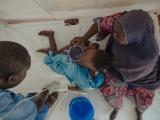Feb 3, 2011
Survey finds 12% of food workers stayed on job while sick
In a multistate survey, 11.9% of restaurant workers said they had worked at least two shifts while suffering vomiting or diarrhea in the previous year, according to a report published in the February issue of the Journal of Food Protection. The survey included interviews with 491 restaurant workers and 387 of their managers in the nine states that participate in the Centers for Disease Control and Prevention's Environmental Health Specialists Network. The states involved were California, Connecticut, Georgia, Iowa, Minnesota, New York, Oregon, Rhode Island, and Tennessee. Restaurants were selected randomly, and only one chain restaurant was included in each state. Factors associated with employees working while sick included (1) a high volume of meals served, (2) no requirement for workers to report illness to managers, (3) a lack of on-call workers, (4) inexperienced managers, and (5) male workers. "Our findings suggest
that policies that encourage workers to tell managers when they are ill and that help mitigate pressures to work while ill could reduce the number of food workers who work while experiencing vomiting or diarrhea," the report says.
J Food Prot abstract
Foodborne botulism a persistent problem for Alaska Natives
Foodborne botulism is more than 800 times more common in Alaska natives than among the overall US population, mainly because of consumption of uncooked meat from aquatic game such as seals, whales, and walruses, according to a report in Clinical Infectious Diseases. Researchers from federal and state health agencies found records of 317 botulism cases and 159 outbreaks from 1947 through 2007. Sixty-one percent of the patents were female. The overall mean annual incidence was 6.9 cases per 100,000 Alaska Natives; those older than 60 were hardest hit, with a mean annual incidence of 26.6 per 100,000. The overall case-fatality rate (CFR) was 8.2%, but the CFR since 1980 has been 4.0% or lower. The fatality rate was higher in cases in which the disease was misdiagnosed and antitoxin treatment delayed.
Clin Infect Dis report
Clin Infect Dis
related editorial (extract)
Experimental blood test for vCJD called promising
British scientists have devised a blood test for variant Creutzfeldt-Jakob disease (vCJD)the human counterpart of bovine spongiform encephalopathy (mad cow disease)that achieved better than 70% sensitivity in the lab, according to a report published online today by the Lancet. The test involves using stainless steel particles to tag abnormal prion protein, the vCJD infective agent, in blood and then using a combination of PrP-specific antibodies and conventional assays to detect the agent. The scientists used the test to look for PrP in a set of 190 masked blood samples from 190 volunteers, including 21 with vCJD, 27 with sporadic CJD, 42 with other neurologic diseases, and 100 normal controls. The test identified 15 of the 21 samples from vCJD patients and correctly classified all 169 vCJD-negative samples, showing 71.4% sensitivity and 100% specificity. The study is praised in an accompanying editorial by Luisa
Gregori of the US Food and Drug Administration (not speaking officially for the FDA). Gregori calls the study "the first report of an assay capable of discriminating vCJD-infected blood from blood of individuals who at the time of sampling were either healthy or affected by non-vCJD neurodegenerative disorders." She notes that while vCJD is very rare, it has had enormous effects on transfusion medicine. A reliable blood test would not only be useful for identifying asymptomatic cases, but also, potentially, for screening blood donations, she writes.
Feb 3 Lancet article abstract
Feb 3 Lancet editorial (extract)
China finds good safety profile for H1N1 vaccine
An evaluation of the safety of China's 2009 H1N1 vaccine campaign found few serious adverse events, with a Guillain-Barre syndrome (GBS) rate that was below the country's background level. The findings were published online yesterday by the New England Journal of Medicine. China conducted its vaccine campaign from Sep 21, 2009, through Mar 21, 2010. Priority groups included healthcare workers, school children and staff, and people with underlying medical conditions. About 90 million people received the vaccine, a nonadjuvanted split-virus vaccine made by 10 producers. A review of adverse events reported to China's vaccine safety surveillance system showed that the adverse event rate was 90 per 1 million doses. Just over 80% of the 8,067 adverse events were determined to be vaccine related, and only 1,083 were defined as more serious. Eleven cases of GBS were reported, which at 0.1 per 1 million doses is well below China's
background rate of 1.9 per 1 million population. The authors concluded that the vaccine had a solid safety profile with no evidence of increased GBS risk.
Feb 2 N Engl J Med abstract


















